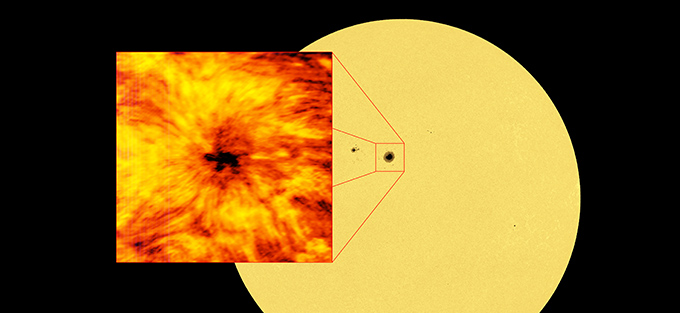ALMA Starts Observing the Sun
New images from the Atacama Large Millimeter/submillimeter Array (ALMA) reveal stunning details of our Sun, including the dark, contorted center of an evolving sunspot nearly twice as large as the diameter of the Earth. These images are part of the testing and verification campaign to make ALMA's solar observing capabilities available to the international astronomical community.
Though designed principally to observe remarkably faint objects throughout the Universe -- such as distant galaxies and planet-forming disks around young stars – ALMA is also capable of studying objects in our own Solar System, including planets, comets, and now our own Sun.
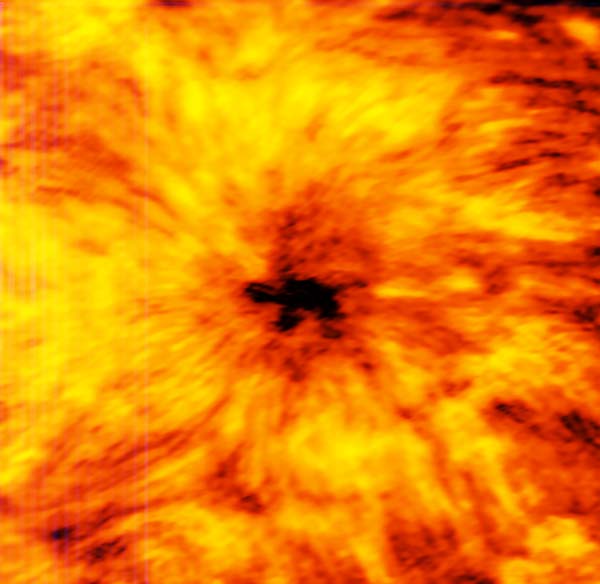
This ALMA image of an enormous sunspot was taken on 18 December 2015 with the Band 6 receiver at a wavelength of 1.25 millimeters. Sunspots are transient features that occur in regions where the Sun’s magnetic field is extremely concentrated and powerful. They are lower in temperature than their surrounding regions, which is why they appear relatively dark in visible light. The ALMA image is essentially a map of temperature differences in a layer of the Sun's atmosphere known as the chromosphere, which lies just above the visible surface of the Sun (the photosphere). The chromosphere is considerably hotter than the photosphere. Understanding the heating and dynamics of the chromosphere are key areas of research that will be addressed by ALMA. Observations at shorter wavelengths probe deeper into the solar chromosphere than longer wavelengths. Hence, Band 6 observations map a layer of the chromosphere that is closer to the visible surface of the Sun than Band 3 observations. Credit: ALMA (ESO/NAOJ/NRAO) | Download image
During a 30-month period beginning in 2014, an international team of astronomers harnessed ALMA's single-antenna and array capabilities to detect and image the millimeter-wavelength light emitted by the Sun’s chromosphere -- the region that lies just above the photosphere, the visible surface of the Sun.
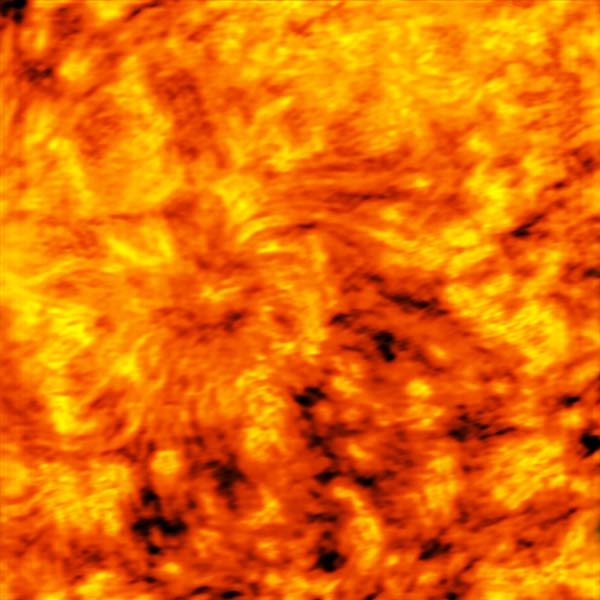
ALMA image of an enormous sunspot taken on 18 December 2015 with the Band 3 receiver at a wavelength of 3 millimeters. Sunspots are transient features that occur in regions where the Sun’s magnetic field is extremely concentrated and powerful. They are lower in temperature than their surrounding regions, which is why they appear relatively dark in visible light. The ALMA images are essentially maps of temperature differences in a layer of the Sun's atmosphere known as the chromosphere, which lies just above the visible surface of the Sun (the photosphere). The chromosphere is considerably hotter than the photosphere. Understanding the heating and dynamics of the chromosphere are key areas of research that will be addressed by ALMA. Observations at shorter wavelengths probe deeper into the solar chromosphere than longer wavelengths. Hence, Band 6 observations map a layer of the chromosphere that is closer to the visible surface of the Sun than Band 3 observations. Credit: ALMA (ESO/NAOJ/NRAO) | Download image
These new images demonstrate ALMA’s ability to study solar activity at longer wavelengths than observed with typical solar telescopes on Earth, and are an important expansion of the range of observations that can be used to probe the physics of our nearest star.
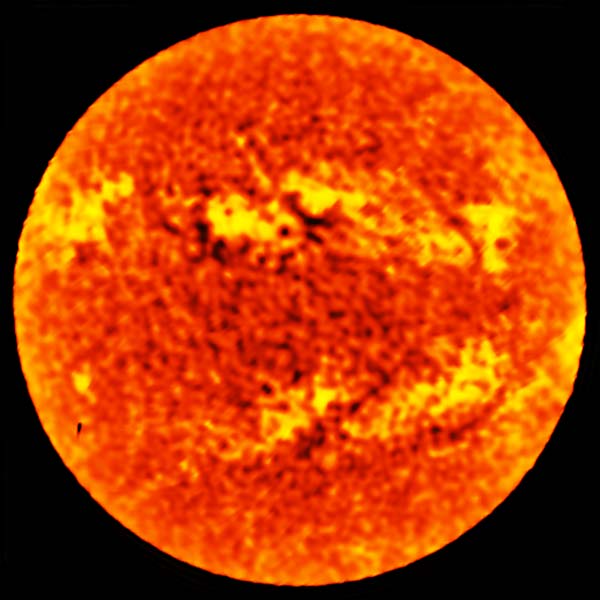
This full map of the Sun at a wavelength of 1.25 mm was taken with a single ALMA antenna using a so-called "fast-scanning" technique. The accuracy and speed of observing with a single ALMA antenna makes it possible to produce a low-resolution map of the entire solar disk in just a few minutes. Such images can be used in their own right for scientific purposes, showing the distribution of temperatures in the chromosphere, the region of the solar atmosphere that lies just above the visible surface of the Sun. Credit: ALMA (ESO/NAOJ/NRAO) | Download image
"We’re accustomed to seeing how our Sun appears in visible light, but that can only tell us so much about the dynamic surface and energetic atmosphere of our nearest star,” said Tim Bastian, an astronomer with the National Radio Astronomy Observatory in Charlottesville, Virginia in the USA. “To fully understand the Sun, we need to study it across the entire electromagnetic spectrum, including the millimeter and submillimeter portion that ALMA can observe."
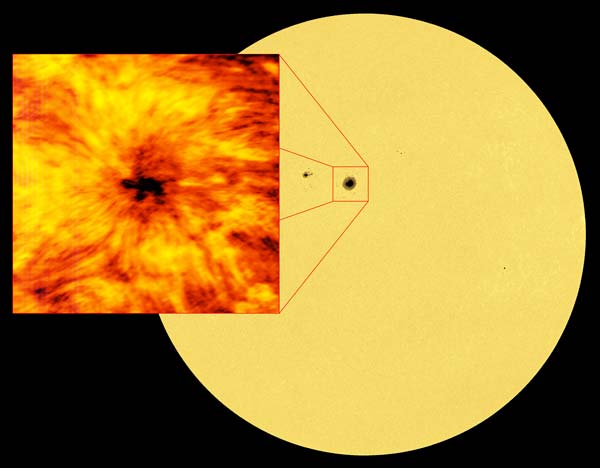
This image of the entire Sun was taken at a wavelength of 617.3 nm. Light at this wavelength originates from the visible solar surface, the photosphere. A cooler, darker sunspot is clearly visible in the disk, and -- as a visual comparison -- a depiction from ALMA at a wavelength of 1.25 millimeters is shown. Credit: ALMA (ESO/NAOJ/NRAO); B. Saxton (NRAO/AUI/NSF) | Full-disc solar image: Filtergram taken in Fe I 617.3 nm spectral line with the Helioseismic and Magnetic Imager (HMI) onboard the Solar Dynamics Observatory (SDO). Credit: NASA | Download image
Since our Sun is many billions of times brighter than the faint objects ALMA typically observes, the solar commissioning team had to developed special procedures to enable ALMA to safely image the Sun without damaging its sensitive electronics.
The result of this work is a series of images that demonstrates ALMA’s unique vision and ability to study our Sun on multiple scales.
Tim Bastian from NRAO explains ALMA observing the Sun. Credit: Images: ALMA (ESO/NAOJ/NRAO) - NASA; Music: Frozen Star by Kevin MacLeod is licensed under a Creative Commons Attribution license (https://creativecommons.org/licenses/by/4.0/) Source: https://incompetech.com/music/royalty-free/index.html?isrc=USUAN1100356 Artist: https://incompetech.com/
Comparison of the solar disc in ultraviolet and millimetre wavelength light. Credit: NASA-SDO, ALMA (ESO/NAOJ/NRAO)
Sunspot seen in visible and millimetre wavelength light. Credit: NASA-SDO, ALMA (ESO/NAOJ/NRAO)
Download images and videos: https://www.almaobservatory.org
Additional information
The ALMA Solar Development Team includes Shin'ichiro Asayama, East Asia ALMA Support Center, Tokyo, Japan; Miroslav Barta, Astronomical Institute of the Czech Academy of Sciences, Ondrejov, Czech Republic; Tim Bastian, National Radio Astronomy Observatory, USA; Roman Brajsa, Hvar Observatory, Faculty of Geodesy, University of Zagreb, Croatia; Bin Chen, New Jersey Institute of Technology, USA; Bart De Pontieu, LMSAL, USA; Gregory Fleishman, New Jersey Institute of Technology, USA; Dale Gary, New Jersey Institute of Technology, USA; Antonio Hales, Joint ALMA Observatory, Chile; Akihiko Hirota, Joint ALMA Observatory, Chile; Hugh Hudson, School of Physics and Astronomy, University of Glasgow, UK; Richard Hills, Cavendish Laboratory, Cambridge, UK; Kazumasa Iwai, National Institute of Information and Communications Technology, Japan; Sujin Kim, Korea Astronomy and Space Science Institute, Daejeon, Republic of Korea; Neil Philips, Joint ALMA Observatory, Chile; Tsuyoshi Sawada, Joint ALMA Observatory, Chile; Masumi Shimojo, NAOJ, Tokyo, Japan; Giorgio Siringo, Joint ALMA Observatory, Chile; Ivica Skokic, Astronomical Institute of the Czech Academy of Sciences, Ondrejov, Czech Republic; Sven Wedemeyer, Institute of Theoretical Astrophysics, University of Oslo, Norway; Stephen White, AFRL, USA; Pavel Yagoubov, ESO, Garching, Germany; and Yihua Yan, NAO, Chinese Academy of Sciences, Beijing, China.
The Atacama Large Millimeter/submillimeter Array (ALMA), an international astronomy facility, is a partnership of the European Organisation for Astronomical Research in the Southern Hemisphere (ESO), the U.S. National Science Foundation (NSF) and the National Institutes of Natural Sciences (NINS) of Japan in cooperation with the Republic of Chile. ALMA is funded by ESO on behalf of its Member States, by NSF in cooperation with the National Research Council of Canada (NRC) and the National Science Council of Taiwan (NSC) and by NINS in cooperation with the Academia Sinica (AS) in Taiwan and the Korea Astronomy and Space Science Institute (KASI).
ALMA construction and operations are led by ESO on behalf of its Member States; by the National Radio Astronomy Observatory (NRAO), managed by Associated Universities, Inc. (AUI), on behalf of North America; and by the National Astronomical Observatory of Japan (NAOJ) on behalf of East Asia. The Joint ALMA Observatory (JAO) provides the unified leadership and management of the construction, commissioning and operation of ALMA.
Contacts
-
Nicolás Lira
Education and Public Outreach CoordinatorJoint ALMA Observatory, Santiago - ChilePhone: +56 2 2467 6519Cel: +56 9 9445 7726Email: [email protected] -
Charles E. Blue
Public Information OfficerNational Radio Astronomy Observatory Charlottesville, Virginia - USAPhone: +1 434 296 0314Cel: +1 202 236 6324Email: [email protected] -
Richard Hook
Public Information Officer, ESOGarching bei München, GermanyPhone: +49 89 3200 6655Cel: +49 151 1537 3591Email: [email protected] -
Masaaki Hiramatsu
Education and Public Outreach Officer, NAOJ Chile
